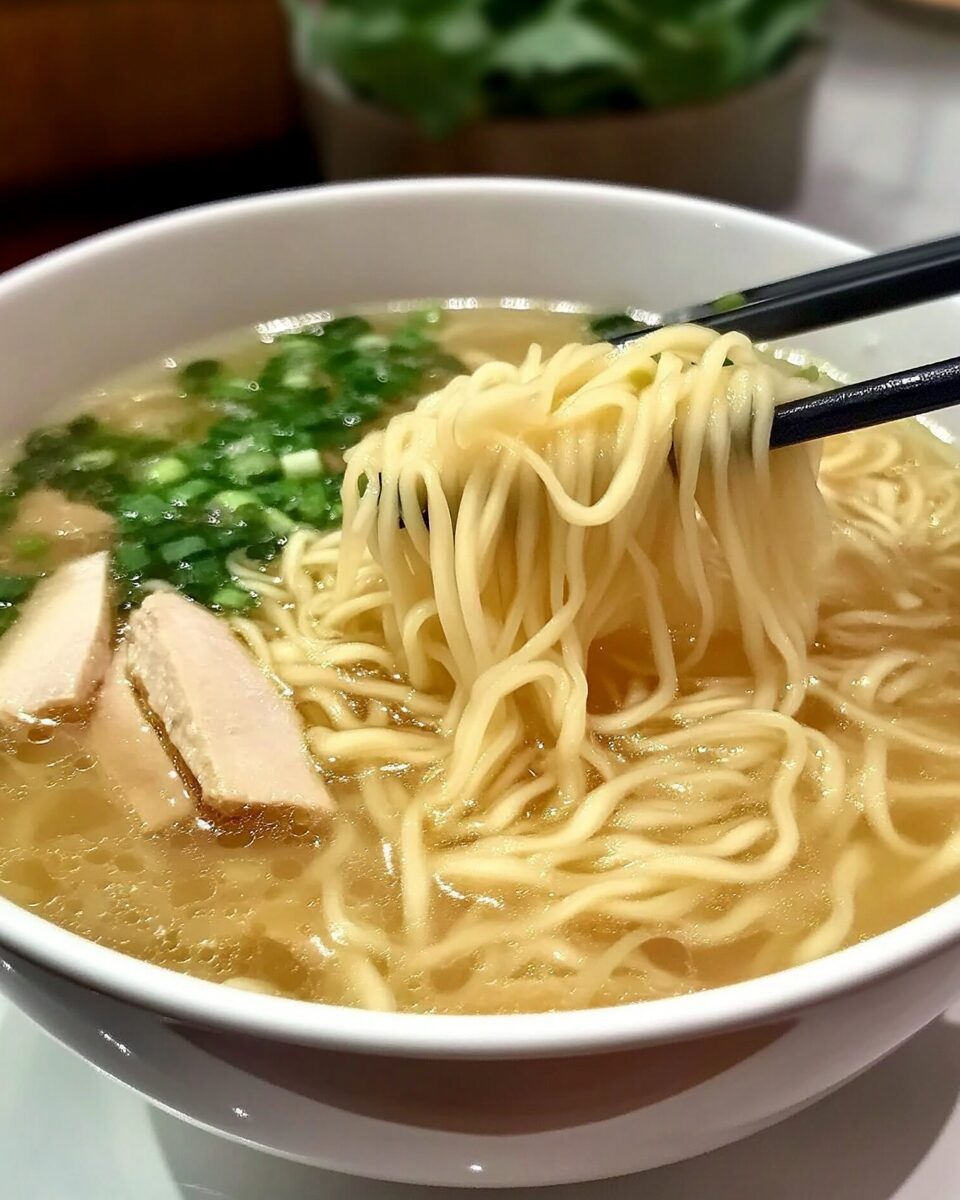This Quick & Cozy Chinese Noodle Soup is the epitome of comfort in a bowl. With tender chicken, hearty noodles, and a flavorful broth, it’s a dish that warms both the body and soul. The addition of bok choy adds a touch of freshness, balancing the richness of the soup.
Ideal for busy weeknights or when you’re craving something soothing, this recipe is both simple and satisfying. Customize it with your favorite toppings like a soy sauce egg or shredded roast chicken to make it your own. Whether you’re a seasoned cook or a beginner, this dish is sure to become a staple in your kitchen.
Full Recipe
Ingredients:
-
200g egg noodles (or any preferred noodle)
-
1 chicken breast (or choice of protein)
-
4 cups chicken bone broth (or vegetable broth)
-
1 tablespoon soy sauce
-
1 teaspoon sesame oil
-
Salt to taste
-
1 cup bok choy (or any mild leafy green)
-
Optional: shredded roast chicken, soy sauce egg, or other toppings
Directions:
-
In a pot, bring the chicken bone broth to a boil.
-
Add the chicken breast and cook for 2 minutes, then cover and simmer for 5 minutes.
-
Remove the chicken, let it cool slightly, then shred it.
-
Season the broth with soy sauce and salt.
-
In a separate pot, bring water to a boil and blanch the bok choy for 1 minute. Drain and set aside.
-
Cook the egg noodles according to package instructions. Once done, rinse them under cold water to firm them up.
-
To assemble, place the cooked noodles in a bowl, pour the hot broth over them, and top with shredded chicken and bok choy.
-
Drizzle sesame oil over the top for added flavor.
Prep Time: 10 minutes
Cooking Time: 15 minutes
Total Time: 25 minutes
Kcal: Approximately 350 kcal per serving
Servings: 2 servings
Introduction to Chinese Noodle Soup
Chinese Noodle Soup is a time-honored comfort dish that has been enjoyed across Asian households for generations. Rooted in tradition yet flexible enough to adapt to modern kitchens, this dish balances simplicity, flavor, and nutrition in a single bowl. Unlike the instant ramen versions that are often high in sodium and low in nutrients, homemade Chinese noodle soup provides a rich, wholesome, and deeply satisfying meal using fresh ingredients and a flavorful broth base.
The key element in this dish is the broth—typically made from chicken, pork, or vegetable stock—simmered to bring out depth and umami. Combined with tender noodles, leafy greens like bok choy, and proteins such as shredded chicken, this soup becomes a complete, nourishing meal. In Chinese cuisine, soups are often regarded not just as food but as a form of medicine, meant to balance the body’s energies, support digestion, and promote wellness, especially during colder seasons.
Cultural Significance of Noodle Soups in Chinese Cuisine
In Chinese culture, noodles symbolize longevity and prosperity. This is why noodle dishes, especially in soup form, are frequently served during birthdays and festive celebrations like Lunar New Year. The long, unbroken noodles are a metaphor for a long and continuous life. Beyond symbolism, soups are also considered part of the traditional Chinese approach to holistic health. Warm, nourishing broths are believed to improve circulation, aid digestion, and replenish energy.
Noodle soups vary across regions of China. In Northern China, you’ll find wheat-based noodles in thick, hearty broths, while Southern China favors rice noodles and lighter, clearer soups. The soup featured here is a simplified, home-style Southern-inspired version that is both adaptable and accessible for home cooks anywhere in the world.
Why You Should Make This Chinese Noodle Soup at Home
Making Chinese noodle soup at home offers numerous benefits over ordering takeout or relying on store-bought options. First and foremost, it gives you complete control over the ingredients and flavor profile. You can choose your protein, adjust the saltiness, add in a variety of vegetables, and even experiment with different types of noodles—from egg noodles to rice vermicelli or whole wheat options.
It’s also incredibly cost-effective. Using leftover roast chicken or homemade broth reduces waste and adds layers of flavor. With just a few pantry staples like soy sauce, sesame oil, and garlic, you can build a complex, aromatic dish that tastes like it took hours to prepare—but in reality, it comes together in under 30 minutes.
This recipe is particularly ideal for families, meal preppers, or anyone looking to eat more nutritious, home-cooked meals. It reheats well, making it a great option for lunches throughout the week, and it can easily be scaled up or down depending on how many servings you need.
Flavor Components and Balance
One of the most beautiful things about Chinese noodle soup is how well it balances the five basic flavors: salty, sweet, sour, bitter, and umami. The broth is usually the cornerstone, delivering a strong umami hit from simmered chicken bones or store-bought bone broth. Soy sauce brings the saltiness and depth, while a few drops of sesame oil add nuttiness and fragrance.
Bok choy or other leafy greens provide a slightly bitter contrast that cleanses the palate, and optional garnishes like green onions or a splash of rice vinegar can introduce freshness and tang. By layering these flavors carefully, the dish becomes far more than just “noodles in broth.” It’s a complex, rewarding bowl that excites the senses.
Nutrition Benefits
Chinese noodle soup isn’t just tasty—it’s also a well-balanced meal. The broth hydrates and provides electrolytes, while the protein from chicken or tofu supports muscle repair and keeps you full longer. Leafy greens add fiber, vitamins A and C, and minerals like calcium and iron. Noodles provide the necessary carbohydrates to fuel your day, and when made with whole grain or rice-based varieties, they can also contribute additional nutrients and fiber.
Additionally, making this dish at home means you can limit processed ingredients and additives. This makes it suitable for people with dietary restrictions, such as gluten-free, low-sodium, or dairy-free diets. You can also tailor the fat content by choosing lean proteins and using minimal oil during cooking.
Toppings and Variations
One of the best parts of this dish is how customizable it is. Beyond the classic shredded chicken and bok choy, you can add soft-boiled soy sauce eggs for extra protein and richness. A drizzle of chili oil or a spoonful of fermented chili paste can add a welcome heat for spice lovers. Some people enjoy adding tofu puffs, mushrooms, corn, or bamboo shoots for additional texture and nutrition.
Noodles are another area where creativity shines. From silky hand-pulled noodles to chewy udon or rice noodles, each brings its own texture and mouthfeel to the dish. Even low-carb versions, such as shirataki noodles or spiralized vegetables, can work well for those watching their carbohydrate intake.
You can even explore regional twists: turn it into a Sichuan-inspired version by adding mala (numbing spice) seasoning, or go for a Cantonese-style bowl with wontons or roast duck.
Tips for the Best Noodle Soup
-
Use a flavorful broth: Whether homemade or store-bought, the broth should be rich and well-seasoned. Add aromatics like ginger, garlic, and green onions during simmering for extra depth.
-
Don’t overcook the noodles: Cook noodles separately to prevent them from absorbing too much broth and turning mushy.
-
Prep toppings in advance: This helps with a quick assembly and ensures that everything stays fresh and vibrant.
-
Finish with fresh herbs or oils: A sprinkle of green onions or a few drops of sesame oil or chili oil can enhance both the flavor and visual appeal.
-
Balance your bowl: Include elements of protein, vegetables, and carbs for a well-rounded, satisfying meal.
How This Dish Fits Into Everyday Life
The simplicity and adaptability of this recipe make it perfect for weeknight dinners, casual lunches, or even as a comforting remedy when you’re feeling under the weather. It’s a dish that bridges generations, evoking memories of home and childhood for many while offering a canvas for culinary exploration for others.
Thanks to its short cook time and minimal ingredients, this soup can be a go-to solution for busy schedules without compromising on nutrition or flavor. It’s also a fantastic recipe for beginners, teaching the fundamentals of soup-making and ingredient balancing in a way that’s approachable and rewarding.
Conclusion
Chinese Noodle Soup is far more than just a quick meal—it’s a deeply rooted cultural dish that carries tradition, flavor, and nourishment in every bowl. Its versatility makes it suitable for all kinds of dietary needs and preferences, and its ease of preparation means anyone can enjoy the rich flavors of Chinese cuisine from the comfort of their own kitchen.
By mastering this simple recipe, you’re not only adding a reliable dish to your weekly rotation, but you’re also connecting with a broader culinary heritage that spans generations and continents. So the next time you’re in need of a comforting, wholesome, and utterly delicious meal, consider making a steaming bowl of homemade Chinese noodle soup—it’s sure to satisfy every time.





